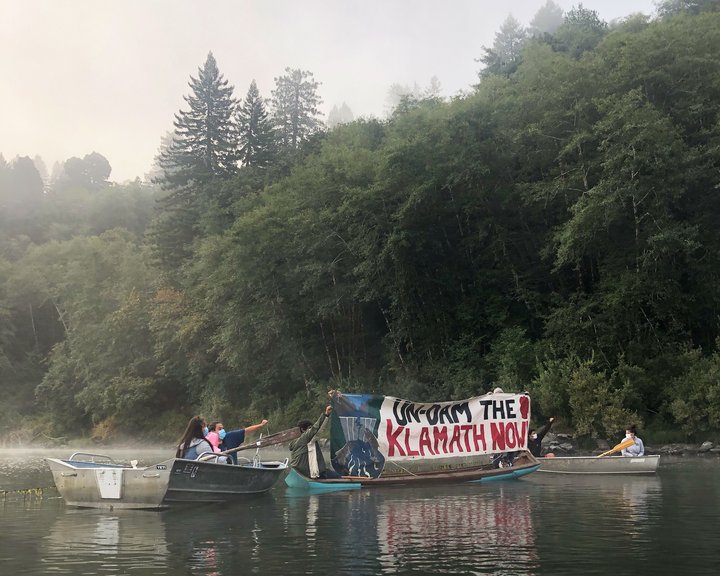
A floating blockade stretches across the Klamath River waiting to stop boats carrying Yurok and Karuk tribal officials and Berkshire Hathaway executives upriver on Aug. 28, 2020. Photo: Mahlija Florendo
###
It was a Friday in late August when four jet boats made their way up the Klamath River under a cloudless blue sky. The boats carried three tribal chairs. From the Karuk Tribe, there was Russell “Buster” Attebery, who’d found pride as a boy catching salmon from the river and bringing them home to his family, and later come to believe some tribal youth’s troubles — from suicides to substance use — could be traced back to their never having had that opportunity, growing up alongside a river now choked with algae and diminishing fish populations. There was Joseph James from the Yurok Tribe, who’d come to see the river’s declining health as a “slow strangulation” of his people — “river people” — who have lived along its banks and relied on its salmon as the bedrock of their diet since time immemorial. And there was Don Gentry, recently elected to a third term as the upriver Klamath Tribes’ chair, whose people hadn’t seen salmon and steelhead swimming in their ancestral territory in a generation.
There were others on the boats, too. People like Craig Tucker, an environmentalist who promised himself in school he’d never waste his career fighting for quixotic causes, yet had now come to spend two decades working on Klamath dam removal. There was Frankie Joe Myers, who’d come of age amid the fight to undam the river and was now in the thick of it as the Yurok Tribe’s vice chair.
But the trip up the Klamath that day in August wasn’t really about any of the people who’d made undamming the river a central part of their life’s work, it was about about making a case to two men who’d never set eyes on the river before but held its future in their hands.
Weeks earlier, after a Federal Energy Regulatory Commission ruling had derailed a hard-fought 2016 agreement to remove the four hydroelectric dams choking the lower Klamath River, Myers and James had issued a plea. While PacifiCorp, the electric company that owns and operates the dams, was publicly musing about walking away from the agreements, Myers and James decided to appeal directly to Berkshire Hathaway, the holding company run by Warren Buffett, perhaps the world’s most successful and famous investor, which had acquired PacifiCorp for more than $5 billion back in 2005.
In a meticulously worded email to Berkshire Hathaway Energy Vice Chair Greg Abel, who’s believed by many to be the 89-year-old Buffett’s successor, Myers said he and James invited one of the world’s most powerful men to simply come see the river, sit and talk. Abel accepted and soon he and Berkshire Hathaway Energy CEO William Fehrman were sitting on a jet boat headed upriver.
It’s hard to overstate the stakes that day on the river. Activists and officials alike had long believed the best chance to fundamentally change the dam-removal conversation was to get Berkshire engaged, a step the company seemed entirely unwilling to take, a core tenet of its company ethos being not to interfere in the operations of its subsidiaries. Yet here sat Abel and Fehrman, the Klamath wind in their hair.
Tribal officials had worked hard to keep word of the visit close, concerned an ill-timed protest or demonstration could jeopardize this show of good faith. They’d mapped out the day carefully to showcase the Klamath’s beauty and potential, planning to give the executives a meandering tour of family fishing holes and camps on the river until eventually landing where Blue Creek enters the Klamath — a scenic spot filled with biological diversity and spiritual significance for the Yurok Tribe — where they’d lunch on traditional salmon cooked on sticks over an open flame. But as the boats rounded a sweeping bend in the river, it became instantly clear some had other plans. A floating blockade — a few boats and dugout canoes, with large nets stretched across the river — came into view, dotted with signs calling for the river’s undamming, some punctuated by red fists.
Myers, who said he’d personally assured Berkshire representatives they would be safe coming to Klamath, said his heart quickened a bit when he saw the blockade, unsure what was to follow.
“It was risky,” Myers said. “There were a few moments when I was like, ‘I have a couple of the richest men in the country on a jet boat and I don’t know what [the protesters] were going to do.’ … Everyone in the boats felt very vulnerable.”
The blockade, which comprised a couple dozen of the Klamath River’s most ardent activists, ordered the jet boats to stop. Then, the activists took turns addressing the representatives of one of the world’s most powerful companies.
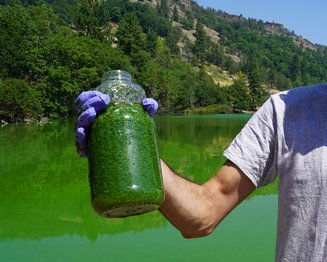
A jar full of Microcystis cyanobacteria in the Copco Reservoir on the Klamath River. The algae produces a carcinogenic liver toxin called microcystin, which is harmful to humans and animals, including salmon. Photo: Stormy Staats.
One of them presented the men with a plastic jug of water pulled from behind one of the dams, where the water is choked with bright green algae and pressed them to open the jug and smell the toxic brew. Another noted that an entire generation of water protectors had been raised in this fight under the oppressive weight of a sick river. Jon Luke Gensaw pulled off his COVID-19 facial covering, telling the men to take a good look at his face.
“If this doesn’t end, you’re going to see more of us,” he said. “I want you to remember my face because you’ll see me again.”
Chook-Chook Hillman, who joined the effort to remove the dams when he was a teenager and whose dad would take him to the meetings with upriver irrigators and ranchers that led to the 2010 dam removal agreement that died in Congress, started by asking his son to present the executives with a gift.
“Thank you — very kind,” one of them can be heard to stammer in a recording of the exchange.
The gift, Hillman later told the men, was a small white flag affixed to a wooden stick. Hillman said he and his fellow water protectors would be waiting when the executives and tribal officials returned downriver. If they waved the flag, it would be a sign that an agreement had been restored. But if not, Hillman warned, Berkshire Hathaway should brace for protests like it had never seen.
“If you guys ain’t waiving that flag when you’re coming down the river — it’s on,” he said.
Annelia Hillman told the executives that the health of the river is their responsibility — their problem — and one that’s going to effect their children and grandchildren, their futures.
“It’s affecting you, too,” she said. “Don’t think this is an Indian problem. It’s your fucking problem, too.”
After a tense 15 or so minutes, the blockade moved to the side and the boats headed on. When they came back down again some hours later, Hillman said no one aboard would make eye contact with him or the other water protectors.
The flag was nowhere to be seen.
###
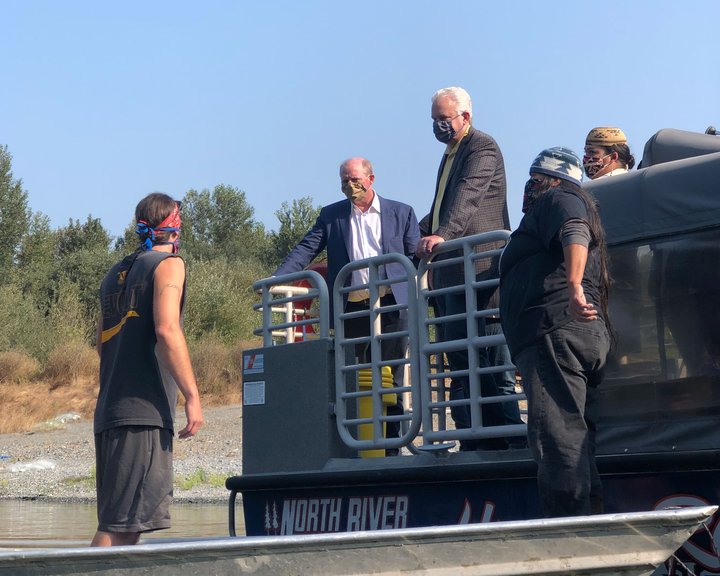
Berkshire Hathaway executives talk to Klamath Justice Coalition activists who stopped them on a trip to the river. Photo: Mahlija Florendo
About six weeks before that day on the river, the Federal Energy Regulatory Commission had issued a ruling that put the groundbreaking dam removal deal — itself a resuscitation of a more ambitious deal reached in 2010 that was dependent on Congressional approval that withered on the vine — in serious jeopardy.
Under the terms of the 2016 deal, the Klamath River Renewal Corporation had asked FERC to transfer the licenses of the four dams to a newly created nonprofit, which would then oversee and assume liability for the removal process, allowing PacifiCorp to step away cleanly. The dams would then be removed using $450 million already raised for the purpose — $200 million from PacifiCorp ratepayers and $250 million in water bonds authorized by California’s Proposition 1.
But FERC ruled the company couldn’t simply walk away from the dams it built and the situation it had created, and would need to remain attached to the dams as their co-licensee until their removal.
Regina Chichizola, the policy director at Save California’s Salmon who has been involved in Klamath dam removal and other watershed restoration efforts for more than a decade, said she had mixed emotions watching the FERC hearing. On the one hand, she said, she personally understood the ruling and why a private company shouldn’t be allowed to permanently alter a river for profit and then simply walk away. She also knew it would mean trouble.
“I know how PacifiCorp is and I knew they would demand more because they always demand more,” Chichizola said.
Within days of the ruling, PacifiCorp began publicly hedging, saying it had undercut some of the main “customer protections” that had brought the company to the table for the deal. This was a foundational shift, it held, and the deal would need to be re-negotiated.
But any sizeable delay would cut sharply against the chances of reaching a new accord and seeing the dams removed, as the pot of money for the project was unlikely to grow and cost projections would escalate with every month or year that passed.
In the days that followed FERC’s ruling, pockets of dam removal stakeholders met quietly, plotting paths forward. Chook-Chook Hillman said he and a handful of longtime river advocates got together on the banks of the Klamath with a whiteboard and started brainstorming. Chichizola held conference calls with environmental groups and other stakeholders. Tucker and tribal leaders pondered their next move. And North Coast Rep. Jared Huffman readied to throw all his weight as a member of Congress at the problem.
They all settled on a single target for what would be a months-long, multi-pronged campaign the likes of which the Klamath had never seen: Berkshire Hathaway and Warren Buffett.
Since Berkshire purchased PacifiCorp back in 2005, many dam removal advocates had felt Buffett was the key to getting the company on board. He wasn’t simply one of the world’s richest man, but the Oracle of Omaha, an almost mythical business figure famed for down-home sensibilities and philanthropy.
Advocates had long sought to turn his attention to the Klamath. For consecutive years, Tucker had bought up as many tickets as possible to Buffett’s annual shareholders’ meetings — known by some as the “Woodstock of capitalism” — schmoozy affairs more focused on symposiums and cocktail parties than balance sheets. They’d successfully bombarded question and answer periods with Buffett with inquiries on the Klamath, staged die-ins in front of black tie events and even had Native women flood a cocktail party at a diamond store wearing traditional regalia to talk to revelers about the Klamath and what it means to them.
“I have no idea how somebody like Warren Buffett thinks,” Tucker said of the rationale for the approach. “It’s hard for me to put myself in the shoes [of someone] who has more money than God. But I do know he’s 90 and I do know he has Native grandchildren. These shareholder meetings of Berkshire Hathaway are big parties. There’s not that much business but a lot of cocktail parties. And I don’t think he wants them to be dominated by talk of the plight of Native people.
But publicly anyway, none of these efforts seemed to get through to the man who’d built an empire at least on the image that he purchased good companies and let them operate as they saw fit.
This time had to be different. And the effort also had to break through amid the COVID-19 pandemic, which made mass demonstrations — and even traditional organizing strategies — dangerous and impractical.
On the banks of the river, Hillman and other Klamath Justice Coalition members decided they would use personal connections to write heartfelt letters appealing to people close to Buffett.
Chichizola and others, meanwhile, plotted a massive social media push. They found Gates scholars willing to post messages in support of dam removal, hoping to catch the ear of Bill Gates, a longtime friend of Buffett’s. And they’d work toward a large scale day of action that would feature an online event as well as on-the-ground protests.
Meanwhile, Myers and James got to work on their letter to Abel, the man many expect to succeed Buffett at the helm of Berkshire Hathaway and its quarter of a trillion dollars in annual revenue, imploring him to come see the Klamath River and its people for himself.
###
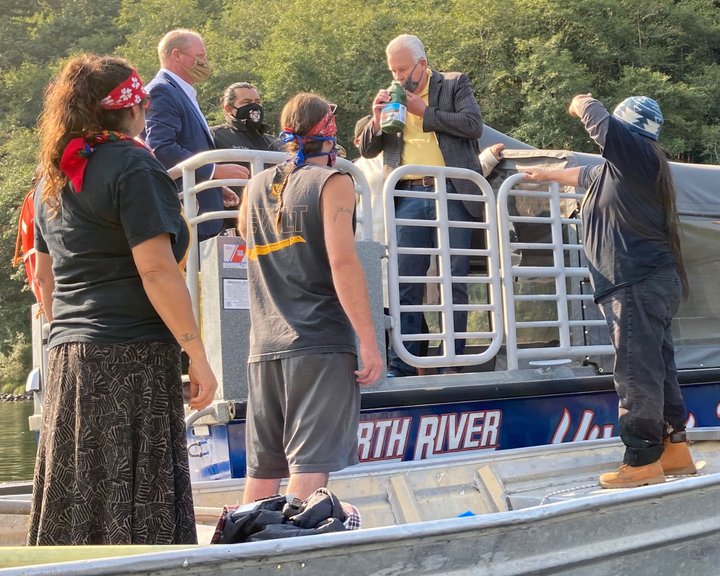
Berkshire Hathaway Energy CEO William Fehrman smells a bottle of toxic algae pulled from above one of the four hydroelectric dams on the Klamath River while speaking to protesters at a blockade on Aug. 28, 2020. Photo: Sammy Gensaw
Ten days prior to the blockade on the river, Huffman convened a special virtual hearing of his Water, Oceans and Wildlife Subcommittee on dam removal and Klamath River conditions. The hearing featured tribal leaders who spoke of the river’s importance to their people; environmental scientists who detailed its dire condition and the dams’ impacts on water quality and fish populations; and North Coast State Sen. Mike McGuire and State Water Resources Control Board Chair Joaquin Esquivel, both of whom indicated the state had taken a light hand with permitting PacifiCorp’s Klamath dams — a practice that would end should the company walk away from the deals.
Berkshire Hathaway sent to the forum PacifiCorp Vice President Scott Bolton, whom Huffman, an environmental lawyer prior to entering politics, seemed to relish questioning.
“Mr. Bolton, I think it’s pretty clear that you and PacifiCorp are at a crossroads,” he said. “You have a choice. The river is dying. The fishery is dying. Your dam is causing a toxic concentration of algae that’s the worst in the world. … But you’re not powerless to protect your ratepayers. We can work shoulder to shoulder, get this done on time and on budget, or you can blow this thing up.”
The comment struck back to something Huffman said in his opening statement, laying the Klamath River’s future squarely at Buffett’s feet.
“Warren Buffett has the chance to be a hero in Indian country,” he said. “Or he has the potential to be remembered as someone who perpetuated a grave injustice just to make a little more money.”
The ensuing weeks would see a bevy of action. Huffman introduced legislation that would have essentially given downriver tribes a voice in FERC’s re-licensing processes, ensuring they would be unpleasant affairs for PacifiCorp moving forward.
Meanwhile, as Chichizola and others pushed toward the day of action in October, protests began to pop up — in San Diego, where PacifiCorp was pursuing a power deal, at the company’s headquarters in Oregon and elsewhere — and Klamath hashtags began to trend.
“One of the things I like to stress when talking about the story is how every single part was in play,” said Chichizola, adding that scientists argued the scientific case for dam removal, politicians played politics, tribal leaders negotiated and coordinated, and a community of activists — many who’d grown up in this effort — organized and rallied.
When the day of action arrived, it was massive, with COVID-19 adapted protests in 11 cities — and in front of Buffett’s home — 7,000 people attending a live online forum and 10,000 signing petitions calling for dam removal. Multiple national Native rights groups joined the social media push and #undamtheklamath began trending on multiple social media platforms. Meanwhile, a coalition took out a full-page advertisement in USA Today calling for dam removal and casting it as a social justice issue.
Tucker said he’s simply never seen anything like it.
“We had protests popping up all over the place that we didn’t really organize and that’s what you want — that’s a grassroots movement right there,” he said.
###
It’s hard to pinpoint the moment it happened — whether it was on the river that day, Huffman’s grilling of Bolton, the scores of heartfelt testimonials on the day of action — but something moved and Berkshire came to the table. (Berkshire Hathaway, through a spokesperson, “declined the opportunity” to be interviewed for this story.”)
But when the company did decide to take PacifiCorp’s position at the negotiating table, stakeholders say everything changed. Myers, the Yurok Tribe’s vice chair, said Fehrman, Berkshire Hathaway Energy’s CEO, stepped in as the company’s lead negotiator and took a granular approach to understanding the agreement, the dam removal process and potential liabilities involved.
Over the course of about a week, a core negotiating team formed, with Fehrman representing Berkshire, Myers representing the Yurok Tribe and Tucker there for the Karuk Tribe, as well as Oregon Department of Environmental Quality Director Richard Whitman and California Department of Fish and Wildlife Director Charlton Bonham. Because everyone’s schedules were packed, the only time they could find to meet were early mornings and weekends, but Myers said no one flinched and the group began meeting three or four times a week, with participants often joining the video conferences from their homes.
“It did bring a certain amount of closeness to these meetings,” Myers said. “The first hour of everyone’s day, people are pretty straightforward with who they are. You get to see people in their homes getting their first cups of coffee. There’s some real humility there.”
Tucker said Berkshire wanted to be walked through every aspect of the plan in fine detail, how construction would work and a detailed breakdown of the budget, the insurance plan and liability concerns.
“We’re talking about removing four large dams — this is on the scale of demolishing skyscrapers or decommissioning giant power plants,” Tucker said. “But they committed to being open-minded and said, ‘OK, you keep telling us this is buttoned up, so let’s go through it again.’ Once we went through it, they were like, ‘Wow, the Klamath River Renewal Corporation has it together.’ … We kind of watched the realization of the company that this wasn’t just some pipe dream. This was well-thought-out and well-managed.”
It was another shift. “And,” Tucker continued, “once they decided they were going to go for it, everything changed. Every interaction with the company was all of a sudden, they are clearly 100 percent committed to dam removal.”
Ultimately, the parties agreed PacifiCorp, California and Oregon would pledge another $45 million in contingency funds to account for cost overruns or liabilities and that Berkshire would agree to a three-way split of any liabilities or overruns beyond that moving forward. But a significant hurdle still remained: Berkshire wanted another entity to take over PacifiCorp’s status as co-licensee on the dams through the removal process. Oregon agreed to sign into the role. But the deal needed California to do so, too.
Myers said Bonham had done a “phenomenal job” throughout the negotiations but indicated this kind of decision was beyond him. The tribes would need to talk directly with Gov. Gavin Newsom.
When tribal representatives met with Newsom in Sacramento, Myers said he knew the stakes couldn’t be higher. His approach, he said, was not to vouch for the science or the economics of the project — others had done that for years. Instead, he said, the goal of the day was to really show Newsom what this agreement would mean to tribal people.
“It was our role to really say, ‘This is worth it,’ and to speak to the 150-plus years of pretty horrific negotiations with California,” Myers said. “When you look at the gold rush in California, when you look at the timber barons in California, the commercial fleets of California, the mission system in California, there is an atrocity built on an atrocity built on the graves of our people. This is the world’s fifth largest economy because it’s built on the resources of the Indigenous people of California. … This is our land and we’re still here.”
After the group finished making its case to the governor and the meeting was wrapping up, Myers said he offered a last push: “California has a huge debt to Indian people and dam removal does not repay that debt by a long shot. But it’s a good down payment.”
Newsom, Myers said, responded: “California is all in and we’re never going to stop until the dams come out.”
###
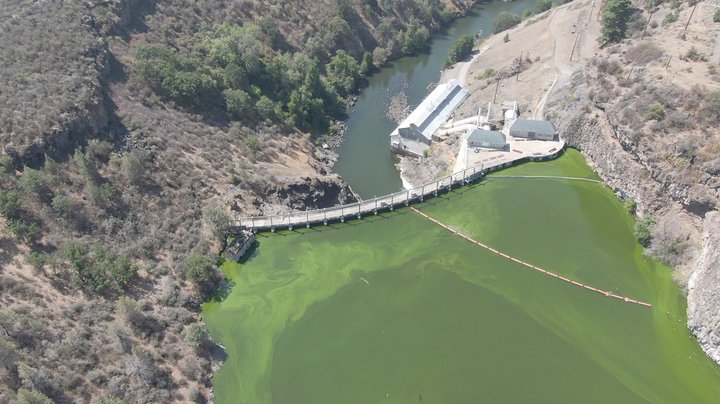
Algae builds up behind Copco 1 dam on the Klamath River. Photo: Karuk Tribe
In late October and early November, word crept into activist circles that negotiations with Berkshire were going well, that there was progress. But it was hard to believe.
“I was still tepid,” said Hillman. I’d heard there was another agreement in principle. Well, I remembered the other agreements in principle. We were hearing that there’s an agreement, that the states are involved. That sounds good. But other agreements have sounded good as well.”
It was mid-November when word began circulating that a press conference was in the works when Newsom, Oregon Gov. Kate Brown, Berkshire Hathaway and the Yurok and Karuk tribes would announce a new deal had been reached. But most interviewed for this story recall a singular moment when this agreement felt not just real but substantively different than its predecessors — a draft press release began to circulate and in it was a quote from Buffett himself. And the quote didn’t talk about ratepayers. It talked about the good of Native people.
“I recognize the importance of Klamath dam removal and river restoration for tribal people in the Klamath Basin,” Buffett said. “We appreciate and respect our tribal partners for their collaboration in forging an agreement that delivers an exceptional outcome for the river, as well as future generations. Working together from this historic moment, we can complete the project and remove these dams.”
For Hillman, who once fasted for 10 days in preparation for a meeting with Buffett only to be turned away, the moment was profound.
“It hit me a lot harder than I thought it was going to, for his words not to be about ratepayers but about restorative justice,” he said. “That day did feel a lot different than it ever has. People say we’ve been here before but I’m saying, ‘Not here.’ We haven’t been here, where the states and the company and Fish and Wildlife are talking about restorative justice. Those statements are hard to walk aback. It sure does feel different.”
Last month, the KRRC filed the new agreement with FERC for approval and, this time, the consensus is it will be approved without issue, having checked all the boxes the regulatory agency laid out with its prior ruling, laying the path for dam removal to begin in 2023. Hillman said he’s heard Berkshire Hathaway representatives have been meeting with FERC staff to make sure everything is in order, noting that he and other advocates were repeatedly denied such meetings.
“That makes me happy on the one hand but just angry on the other,” he said. “We’ve always known that if the big wigs decide they want to do something as a corporation in America, they do it. They could have done this the whole time.”
But they didn’t. Repeatedly. So what, after years of pushing and angling, finally brought Buffett to the Klamath table? Everyone interviewed for this story said it’s impossible to pinpoint any one thing, as changing economics and political sentiments coupled with stalwart generational activism all created a perfect storm. But if there was a tipping point, Myers and Tucker said it was likely that moment on the Klamath when a group of Native people seeking justice for their river refused to let Berkshire Hathaway executives pass.
“At the end of the day,” Tucker recalled, “I was like, ‘I’m not sure that went the way we wanted it to.’ The tribal activists became a little confrontational and I thought in the moment, ‘Oh, no.’ But what I thought was things going off the rails and all our best laid plans starting to go awry I think was serendipitous. It created opportunities for interactions that wouldn’t have happened otherwise.
“No one sells the Klamath better than the people who live there,” Tucker continued. “People’s entire adult lives have been spent fighting these dams. My child is 16 years old and that’s all he’s ever known that I do. And I think there’s a lot of Native kids who have grown up, and that’s all they know their parents do. … We are committed. And it’s generational. If something happens to me, something happens to Frankie (Myers), something happens to whoever, there’s a generation of young people who will step in to fill our shoes. I think Berkshire finally understood that.”
###
Thadeus Greenson (he/him) is the Journal’s news editor. Reach him at 442-1400, extension 321, or thad@northcoastjournal.com. Follow him on Twitter @thadeusgreenson.
The Community Voices Coalition is a project funded by Humboldt Area Foundation and Wild Rivers Community Foundation to support local journalism. This story was produced by the North Coast Journal newsroom with full editorial independence and control.
CLICK TO MANAGE